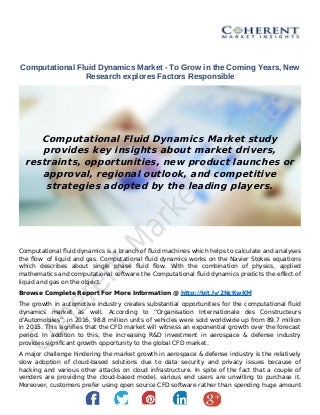

- Ultra chip computational fluid dynamics benchmarks full#
- Ultra chip computational fluid dynamics benchmarks code#
- Ultra chip computational fluid dynamics benchmarks free#
- Ultra chip computational fluid dynamics benchmarks mac#
The following is an example of message in case of check failure: Otherwise, the message warns that the check FAILED and displays the initial and final values of the mass together with the corresponding relative error. If the simulation gives a correct result the following message is print:
Ultra chip computational fluid dynamics benchmarks code#
This simple check is enough to make sure that the code has executed correctly. The code performs the simulation, and at the end it checks that the fluid mass in the whole simulation domain has not changed from its initial value (up to a relative error of 10 -10). X=1024 and Y=4096) and number of iterations is approximately 100000. To do this, a reasonable choice of the lattice size is such that the aspect ratio of the X and Y sizes isġ:4 (e.g. In the present setup the code performs a simulation of the evolution of the Rayleigh-Taylor instability. The control file provides - one per row - the following input parameters: The code supports 1D and 2D domain decomposition. The MPI+CUDA and MPI+OpenACC versions also support CUDA-aware MPI communications that overlap with compute, while the MPI+C version is vectorized and multithreaded. The code is implemented in several versions, including MPI+CUDA and MPI+OPENACC running on GPU-clusters, and also MPI+C, running on CPUs clusters. The two kernels are therefore able to stress and benchmark both the memory and computation sub-systems of recent GPU and CPU processors. Computation is performed in double-precision, and the code includes two computational relevant kernels: one kernel, "propagate", is strongly memory bound, and the other, "collide", is compute bound with an arithmetic intensity of approx 11 FLOP/BYTE.
Ultra chip computational fluid dynamics benchmarks full#
D2Q7 or D2Q9 - as it is able to describe in full details the thermo-hydrodynamical behavior of a fluid, whose equation of state is that of a perfect gas. From a physics point of view, this model improves the accuracy of simpler LBM methods - e.g.
Ultra chip computational fluid dynamics benchmarks mac#
(*) corresponding author, sebastiano.schifano _at_ Mac Studios M1 Ultra Chip Outperforms on Computational Fluid Dynamics Benchmarks. Raffaele Tripiccione (University of Ferrara and INFN).Sebastiano Fabio Schifano (University of Ferrara and INFN)(*).Mauro Sbragaglia (University of Rome "Tor Vergata" and INFN).Alessandro Gabbana (University of Ferrara and INFN).Enrico Calore (University of Ferrara and INFN).


Luca Biferale (University of Rome "Tor Vergata" and INFN).Submitted by Sebastiano Fabio Schifano sebastiano.schifano _at_ Wim De Malsche) and the Mesa+ Institute for Nanotechnology (co-supervision of Prof.SPEChpc™ 2021 Benchmark Description Benchmark Name
Ultra chip computational fluid dynamics benchmarks free#
This is a joint project between the Free University of Brussels (supervision of Prof. de Malsche et al., (2007), Integration of porous layers in ordered pillars for liquid chromatography, Lab Chip, 7, 1705-1711 SEM images of a porous shell micro pillar array as part of a microfluidic system for separation by chromatography. In the second stage of the project, co-operation takes place with a PhD student who will implement the developed technology for microfluidic applications such as chromatography, a field wherein this developed technology will be key to increase the separation performance by orders of magnitude. Devices are studied, designed and manufactured in the cleanroom. The achievable flow configurations are studied by computational fluid dynamics simulations as well as experimentally with a microscopy setup and in-house developed detection. Unique flow profiles are generated in confined spaces, capable of enhancing mass transfer and minimizing dispersion. This project has both an experimental and a modeling character, comprising an experimentally study of the electrical properties of modified silicon surfaces and the impact on electroosmotic flow behavior and mass transfer. Craig Hunter has been running Computational Fluid Dynamics (CFD) benchmarks on Macs for years-he has results going back to 2010 with an Intel Xeon 5650, with the most recent being a 28-core Xeon W from 2019.


 0 kommentar(er)
0 kommentar(er)
